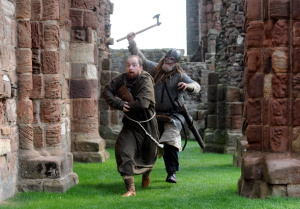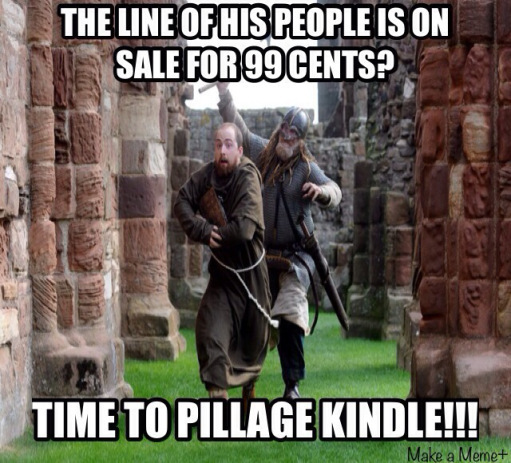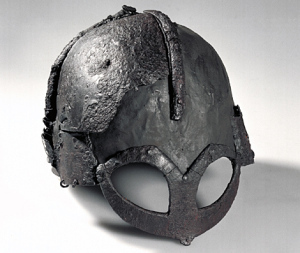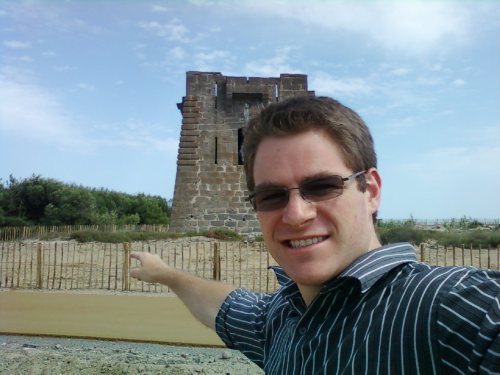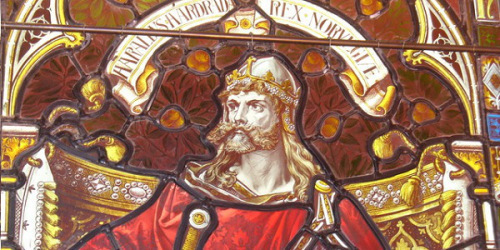C.J. Adrien's Blog, page 25
June 11, 2014
Three Lessons to Learn from the Vikings
It is easy to dismiss the history of the Dark Ages as irrelevant to the development of modern society. Yet, looking back to the days of pillaging and conquest, there are a few simple lessons which we can apply today.
Lesson 1: Terror is Effective.
In the era of “war on terror”, enemies have become difficult to distinguish from ordinary people. Because of this, it appears the world has elected to militarize more than ever and impose massive intelligence operations on the denizens of nations. This is not necessarily different from the beginning of the Viking Age in the Frankish Empire. The Norse raiders attacked speedily and departed from the crime scene before any formal defense forces could be mustered. Take for example the attack on Nantes in 843 A.D. in which the Vikings entered the city in disguise during a religious festival. They sneakily unleashed a violent and bloody fury upon the city. In a chronicle mentioning the event, the people of Nantes were especially shocked that they were unable to identify the evil attackers, nor able to tell them apart from the regular tradesmen who frequented the city. The ambiguity behind the threat of the Vikings created a sense of terror. It might even be said that the first Viking raids were in fact acts of terrorism. As a result of the constant raids and inability of the Frankish leadership to retaliate, the Viking Age ushered in a new era of violence and discord. A massive shift towards militarization specifically to defend against the Vikings heralded the new epoch of violence we today associate with the Dark Ages. After all, with more soldiers, one can wage more wars. The Frankish Empire collapsed and fell into civil war. This perhaps should serve as a lesson: the wisest response to terror may not be to militarize, for it will undoubtedly plunge us into a series of unintended conflicts.
Lesson 2: People Use Religions to Justify Ridiculous Things.
One need look no further than Charlemagne’s massacre of his Saxon prisoners on the Elbe river to see that religion was used to justify ridiculous things. The Saxons were forcibly baptized, then drowned in the name of Christ. Blatant murder was justified as doing God’s work. But of course the story does not end there. No, it continues at Lindisfarne some half a decade later when the Vikings first attacked the English coast. In Scandinavian warrior culture, it is not acceptable to slaughter the unarmed unless merited by either a blood feud or a legitimate cause such as plague or famine. Yet, the Vikings at Lindisfarne massacre everyone in sight. Some of the priests were even dragged to the shore where they were forcibly drowned in the waters. And therein lies the evidence: Lindisfarne — according to a growing number of academics — was a retaliation in the name of religion. Many more priests would find this out the hard way throughout the Viking Age. This tug of war between religions at the beginning of the establishment of Christendom is an incredible insight into the folly of religious sentiment and fervor insofar as it was during this time used to justify horrendous acts of violence. But wait, that sounds indelibly familiar…
Lesson 3: Exporting Money Collapses Economies.
Danegeld was a tribute of gold and silver given to the Vikings in return for not attacking you. This worked well, except for the fact that the Vikings continued to return and ask for more money. The Danegeld tributes became so large in fact that it collapsed the primitive economies of the kingdoms of Charles the Bald and his brother Louis the German. It turns out that sending all of your money abroad tends to have a negative impact on your economy. How does that relate to today? Well, the super rich (i.e. the 0.01%) don’t like to keep their money in one place, especially away from places that might want to tax them. Thus, a significant portion of money is leaving the economies of western economies favoring the emerging economies of the east and south. What will be the result? Let’s just say that people were very, very hungry in 9th and 10th century Europe.
There are many more lessons to be learned from the Viking Age, and they are easy to find. It is as simple as opening up a book and learning. Oh yes, the Vikings liked to learn too.
Don’t forget that The Line of His People is on sale on kindle this week for $0.99! Buy your copy today to experience the next great Viking adventure novel to pillage the literary world!


June 10, 2014
Odin: Seeker of Knowledge
One of the most prevalent myths in Norse mythology is Odin’s visit to Mimir’s well. In the myth, Odin visits the well for he knows that a drink of the well’s water will give him knowledge of the future. The price? Odin must sacrifice an eye. The myth is demonstrative of an important value in Scandinavian society: learning. Vikings, while known for their conquering virtues, were also very interested in learning about the world. From their travels they brought back new knowledge which helped them in metal work, agricultural practices, building and crafts, among other things. These were by no means an unenlightened people, despite what the Christian chronicles might want their readers to think.
Don’t forget that The Line of His People is on sale this week for $0.99 on Kindle! Buy your copy today!


June 9, 2014
Pillage Kindle!
June 8, 2014
Horses in Viking Age Scandinavia
DID YOU KNOW that the Vikings made little use of horses? While contrary to the portrayal of Vikings in the movies and certain television shows, animal husbandry was both incredibly expensive and difficult to manage in Viking Age Scandinavia. Clues to the limited availability and quality of horses can be found in the various sagas which either neglect to ever mention horses or make reference to small horses used specifically for farming purposes. In the sagas we know of a legendary king who even challenged a horseman to a race through Jutland and won, demonstrating the king’s exaggerated prowess as well as the shortcomings of horses at the time. In fact, the first cavalry (if we may call it that) put together by a Scandinavian army was the army of William the Conqueror, whose Knits would become the prototypes for the well known medieval knights. In Normandy, the settler Scandinavians were able to raise horses due to the open spaces and plentiful crop yields of the land, all of which were unavailable in Scandinavia. Hence, the shield wall and advanced ships were the tools utilized by the Vikings, and not horses. Their armies travelled by sea or river, or occasionally on foot, but horses were too expensive and difficult to raise and field for them to be practical.
If you love the Vikings, buy The Line of His People, on sale Monday June 9th for $0.99!!!


June 6, 2014
The Vikings: Excellent Raiders, Poor Field Soldiers, and Why They Did Not Conquer Europe.
Photo: 881 Battle of Saucourt-en-Vimeu: Louis III of France defeated the Vikings, an event celebrated in the German poem Ludwigslied.
Recently, the Vikings have experienced a surge in popularity through the show Vikings on History Channel. In the show they are portrayed as ruthless warriors who easily subdue their victims on raids in England. The myth that the warrior culture of Viking Age Scandinavia allowed the raiders to dominate the rest of the known world for a short time certainly has an appeal to those who profess some sliver of Norse heritage. However, it must be noted and known that the Vikings, although prominent in historical discourse of the early medieval period, did not make effective land armies. The reason for this lies precisely in the warrior culture which many attribute to the success of the Vikings. Their desire for glory in battle, for songs of great deeds, and for recognition from their peers made the Vikings an unusually individualistic society of warriors. Individualism, while effective on small scales, creates problems for large armies competing for supremacy.
One need look no further for the damaging effects of individualism in western warfare than the battle of Crécy of the 100 Year’s War. A small band of English soldiers faced the prospect of annihilation before a much larger and better equipped coalition of French noblemen under the command of the French king. Knights, who comprised the bulk of the French army, tended to be haughty and individualistic and sought glory on the battlefield to justify their lifelong devotion to the art of warfare. As the French army arrived, the knights nearest the English army — composed primarily of conscript archers under the command of a select few knights — decided to charge the English head on in an attempt to singularly defeat the English and earn the recognition and respect of the other knights. In reality, this foolhardy attempt at glory allowed the English to pick off the French knights one by one, taking full advantage of their disunity. The result was complete devastation for the French army. (To read the full account of the battle, read Chronicle, by Jean Froissart)
Disunity allowed a smaller, better organized force of soldiers with less training to triumph at Crécy, and in this same way the Vikings displayed a similar disconnect between their warrior culture and the style of warfare utilized by the Franks in Western Europe. It could be argued that the Vikings were in fact unified, citing the shield wall as an example of how they worked together. The idea behind the shield wall is interesting, but lacks real credibility in the sense that no one really knows what a shield wall would have looked like for sure, and we know from our primary sources that most engagements resorted to singular combat. We also know from our sources that Viking culture was individualistic; hence the plethora of heroes who exist within the various sagas and emerge as treasured example setting leaders. It is therefore not absurd to conclude that the Vikings were intensely individualistic. In fact, one of the great cultural vestiges left by the Vikings in Western Europe after the Viking Age was this same warrior culture which led to the age of knights. That age too came to an abrupt end however during the slaughters of the 100 Year’s War.
Another disadvantage for the Scandinavians of the time was the lack of good and consistent animal husbandry. The geography of Scandinavia did not allow the raising of horses in large numbers, and therefore prevented the Vikings from developing cavalries such as the ones found in Spain and France. We know from extensive catalogues of conflicts involving cavalries that horses gave armies a tremendous advantage over non-cavalry-able foes. Horses remained a significant battle tool through the first world war, demonstrating their unique and intrinsic utility in battle. Vikings had no such tool. In fact, it is mentioned in the Heimskringla (King’s Saga) that a legendary king once raced a horsed soldier on foot. The king one, indicating that horses were not seen as necessarily beneficial to a rider, and that the stock of horses available to Scandinavians may have been poor. In any case, no great cavalries emerged from the north, and therefore the Viking warriors on foot would not have posed any significant challenge to the well trained and well organized land armies of the Frankish Empire (who also emulated the tactics of the Romans).
What made the Vikings effective, and what allowed them to make such a deep mark on history was their ability to attack swiftly and depart even faster due to the mobility of their ships. Long ships developed as the result of a long and proud maritime culture which has its roots in the geography of Scandinavia: numerous waterways separate the sparse settlements of the Fjords. Once the population of Europe feared these men, they harnessed the ideals of psychological warfare to intimidate their foe and tricking them into believing they were facing an unbeatable enemy. An example of this comes from the siege of Paris where sources tell that the city guard collapsed and retreated at the sound of the Vikings‘ roaring. Eventually, the armies of Western Europe came to understand the Vikings, and were able to field armies capable of repelling raids. Once this realization became apparent, the Viking Age quickly ended.
We can be certain, however, that Viking warriors were among the most fearsome combatants in history. Their devotion to combat would have made them skilled fighters in single combat. Facing a small contingency of enemies, they were unbeatable. Against the organized, calculated, and clinical stratagems of a professional army, the Vikings stood little chance.
Thank you for reading! Keep in mind that The Line of His People will be on sale for $0.99 starting Monday June 9th for a very limited time!


June 5, 2014
Author Update
Author Update:
To my loyal fans who have supported the adventures of Abriel since the beginning: the adventures are soon to continue! This past year has challenged my abilities to manage multiple projects at once, but this most arduous period of my professional career will soon be at an end. I am now, as mentioned before, about to embark on the most difficult journey any scholar can make; I am currently working towards a ph.D in History with a dissertation focus on Abriel’s world, the island of Noirmoutier (Herius) and the Vikings who both pillaged the island and lived there. This scholarly quest, however, will in no manner mark the end of Abriel’s adventures in the literary world. In fact, his journeys will be much closer to real history than any other fiction character in the Viking genre. This summer, I will be working on re-releasing The Line of His People in a second edition for the one year anniversary of the original release date. The sequel to the first novel, titled In The Raven’s Wake, has an expected release date of December 1rst, 2014. In the Raven’s Wake will follow Abriel to the edge of the know world, to Kiev, where he will fight for freedom, then seek revenge on his new enemies. The third installment of Abriel’s saga will not follow Abriel. Instead, it will follow Abriel’s daughter Asa who will face great peril during the Viking invasions of Brittany (847 C.E.).
I hope that all my fans will be as excited as I in the coming months where I will share with them (you) any and all new and intriguing discoveries about the past that I discover myself on my scholar’s journey. Again, thank you all for your support!
C.J. Adrien


May 18, 2014
Contribute to the study of Vikings!
Have you ever wondered what you can do to help advance our knowledge of the #Vikings? Support the research of Christophe Adrien and follow his work on his site:
Contribute today!


May 15, 2014
Growing Up Viking
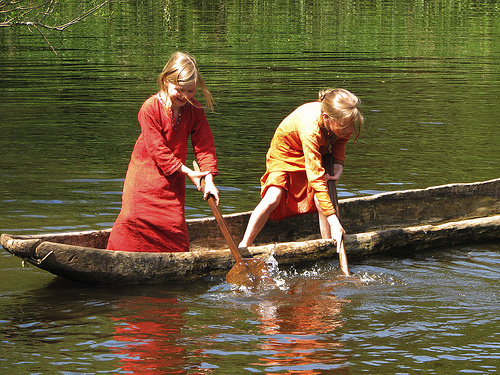
The Icelandic Sagas tell of two boys who wrestled each other in the mud while their mothers chatted amiably. As the children rolled about, they quickly turned from playful to bellicose. One of the children raised a rock and bludgeoned the other to death with repeated skull-crushing blows. The mother of the victim rose to her feet. Rather than cry out, she turned to the other mother and said, “your son will make a good Viking some day.”
This tale indicates the extent to which the Vikings sought to create an image of strength and prowess for themselves. Yet, this is a story from a saga, and we know that Viking Age Scandinavians embellished their stories to impress their audiences. Thus, the tale of the murder of a child by a child can safely be considered a fiction. What would childhood have looked like to the children of the Vikings? As it turns out, they would have experienced a similar childhood to those children who grew up in the Frankish Empire.
The Vikings were first and foremost farmers. Their warrior culture emerged from the function of a farm in relation to its inhabitants and neighbors. Scandinavia’s farming season historically was short, therefore food was often in short supply. It is no surprise that conflicts over food created a great deal of the political strife among petty kingdoms and farmsteads of the Viking Age. In Scandinavian culture, men held the responsibility of defending the farm from outsiders, and thus had to train for war constantly. Women could take this role if their husband had died, but as a general rule men did the fighting. Women and children, with the occasional help of the men, had the key responsibility of farming.
Boys began training with weapons in their teenage years when their muscular development allowed for them to lift heavier objects. Girls trained to take over the farm: they learned to manage slaves, food stocks, cooking, clothes-making, grooming, among other things. Each had a set role, and each child’s future was more or less preordained by society’s structure. The expectations of the children would have been rigid, and the Vikings had little tolerance for those who broke the mold. Considering the high mortality rate among children — which was consistent across Europe — children would have been highly valued by their parents, and thus the family unit would have been much closer than what we even see in today’s society. Archeological digs have turned up dolls and toy ships, demonstrating the Viking culture of highly investing in the rearing of their children.
To think that the Vikings were mere savages is a travesty. To believe that the afore mentioned saga story was a factual account of how Scandinavians treated each other is wrong. Yet, it is this image that we are left with today. Historians continue to mend the damaged reputation of the Vikings, which was terribly skewed by the biases of 19th century historians. As it turns out, Viking children were no more violent or evil than the Christians to their south.


May 10, 2014
King or Earl? Quirks of the Viking Hierarchy
The conclusion the the History Channel’s Vikings left audiences with the impression that their fictional protagonist Ragnar had attained greater status as a result of slaying his former ally King Horik. Is he King? Is he still Earl? What’s the difference? Ambiguity on the part of the writers seems appropriate considering the historical structure of hierarchy in Viking Age Scandinavia. Titles among the ruling class remained inconsistent across Scandinavia throughout the Viking Age, which would eventually cause dissolution and discord among rival kingdoms whose claims of legitimacy over the other partly rested in their self-concept of their title and power.
Each region in Viking Age Scandinavia operated slightly differently than the other. Preceding the Viking Age, Vestfold (modern Norway), and Jutland (modern Denmark) were loose confederations of smaller farm owners who elected a chieftain or leader to make certain legal decisions typically regarding land disputes, feuds, and rights of inheritance. As the weather improved and population soared closer to the outset of the Viking Age, the dynamic of the political structure of each changed dramatically. In Jutland, a presiding king ruled by consent over Jarls — or earls — who managed each individual settlement. For example, in 815 A.D. Jutland was ruled by a certain King Horik, and his time was primarily spent visiting with and ruling through the various Jarls under him. Most prominent among these Jarls was the Jarl of Hedeby who frequently contended with the encroaching and bellicose Frankish army based outside of Hamburg.
In Vestfold, every farmstead leader seems to have thought of himself as king. In the sagas pertaining specifically to Vestfold, we encounter petty kings, but still all self proclaimed kings. For example, the ruler of a small region on the coast of Vestfold named Agder was known as King Harald Granraude. Agder had but one farmstead named Tromoy, thus making King Harald king of one farmstead. We must keep in mind, however, that the term farmstead when referring to the Viking Age signifies a larger than average agricultural settlement; a town of sorts. Further inland, Harald Granraude’s rival Gudrod the Magnificent (Halfdansson) was also king. He presided over more farmsteads and more people, but the title remained the same. This division in the political system of Vestfold which allowed any man with the least amount of power to proclaim himself a king caused constant inter-farmstead warfare. This warfare would not be resolved until much later in the Viking Age when Norway was united under Harald Fairhair.
If this all seems somewhat confusing, that is because it is. There was a lack of consistency across the Viking world and the acquisition of new lands abroad made matters even more confusing (such as the case of Rollo in Normandy). It appears that, with the exception of some places, most petty rulers were legally allowed and encouraged to proclaim themselves king. Thus, it seems, the terms king and Jarl are partly interchangeable (with exceptions of course), if not altogether illogically allocated.
Would you like to meet king Horik and Gudrod the Hunter? Then read The Line of His People, and epic historical fiction adventure set in the early Viking Age!


May 2, 2014
The Most Unusual of Miracles
A few days ago I came across a manuscript — Gestes des Saints de Redon — from 9th Century France which made an explicit reference to an oil lamp fueled by whale blubber. It took a few readings to determine that I in fact was no hallucinating. How then could the monks have procured oil from whale blubber if whaling did not exist in Western Europe at this time? I searched and searched for anything that might explain this anomaly that I had discovered. Finally, I found it: the abbot Ermentaire of Saint Philbert mentioned in one of his manuscripts, Vie et Miracles de Saint Philbert, that God had bestowed the most wondrous of miracles on the monks on the abbey in Noirmoutier. A beached whale had appeared on the northern coast of the island. Immediately, the monks rushed to the carcass and pulled it apart. They used the meat for food, the bones for tools, and the blubber was refined into oil for their lamps. One never evokes 9th century Breton monks as having a whale economy, but it turns out they depended on the regular beaching of whales (about one ever two or three years) for a variety of uses, including the lighting of their oil lamps.



